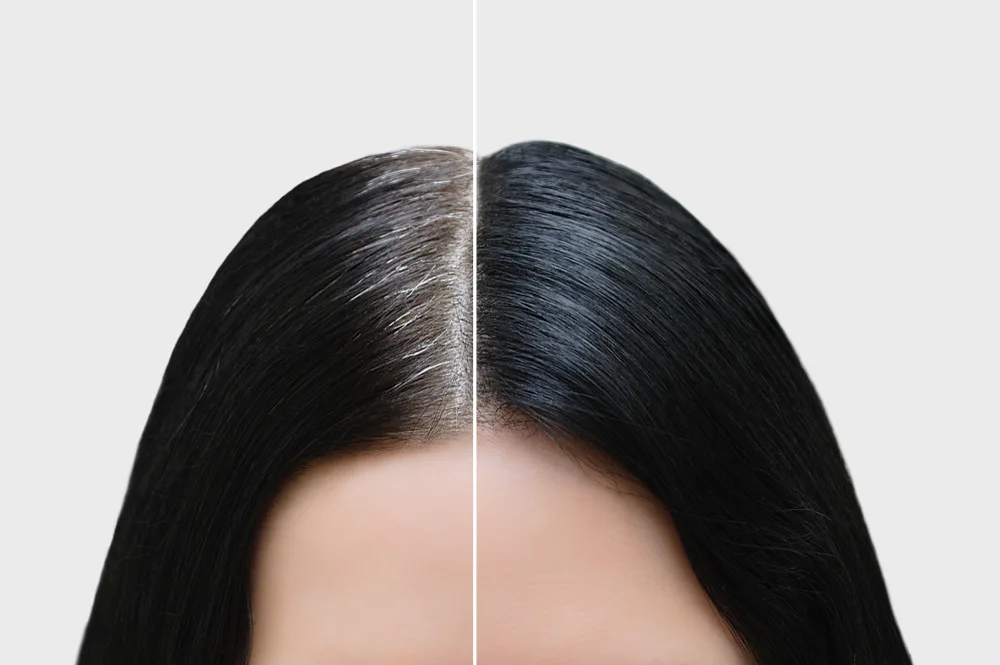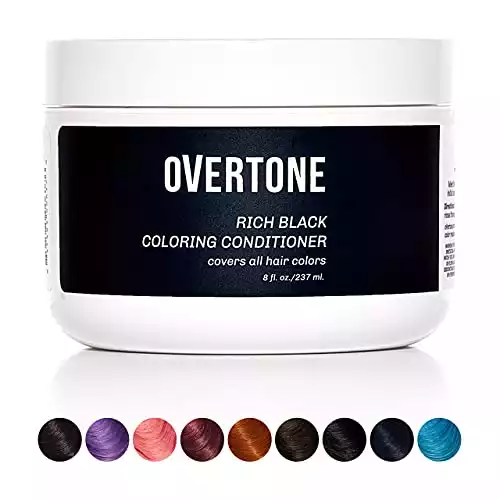Jump to:
If you’ve researched hair dyeing methods that don’t damage your hair, you’ve probably heard of oVertone. Before purchasing the product, you may have additional questions like, “does oVertone cover gray hair?” We’ll cover all you need to know below.
What Is oVertone & Does It Work on Gray Hair?
oVertone is a conditioner-based product that consumers have used successfully to dye gray hair. However, not everyone achieves the same results. While some treatments are effective, others are not for various reasons.
For those unfamiliar with the brand, oVertone isn’t a dye. Dyes use chemicals to lighten and prepare hair to accept color. Like dyes, the conditioner deposits pigment, changing the color of hair.
Learning more about the product, dyeing gray hair, and why semi-permanent treatment sometimes won’t take will give you a better idea of whether oVertone works for you.
Effectiveness of Dye on Gray Hair

Yuliya Alekseeva/Shutterstock
Semi-permanent hair colors, like oVertone, won’t remove or alter gray hair. These types of treatments add pigment to the hair. Colorists use these products to blend in grays with the rest of the hair, but the gray hair may not take up all of the color.
These coloring agents deposit pigments without damaging hair. Semi-permanent products work without a developer. If you’re looking for full gray coverage, a different product will probably work better than semi-permanent color.
Full Gray Coverage vs. Blending Gray
Before committing to any product, consider your goals for changing your hair color. Are you hoping to conceal grays with a pop of fun color? Do you want your colored hair to blend in with your natural color? Or do you want to eliminate gray hair?
Blending gray hair provides many options for how to treat your hair. Semi-permanent color, highlights, lowlights, and balayage are popular techniques for blending in gray hair.
For those who want to get rid of their gray hair, a full coverage treatment is required, usually with permanent dye. These treatments use lightening agents that contain chemicals that can damage hair over time.
When to Stop Dyeing Gray Hair
People who use dye treatments to cover up their gray hair may think they’ve found a permanent solution. However, treating hair long-term with chemicals can damage hair, especially gray hair.
Gray hair tends to be thicker and coarser. The cuticle, or outer layer of the hair, becomes thicker over time, making it harder for pigments to take hold. The more gray hair you have, the more difficult it will be to dye.
Coloring gray hair isn’t impossible, but even effective treatments need to be discontinued over time. Hairstylists are trained to recognize the signs of when it’s time to stop coloring their client’s hair. These are a few common reasons professionals recommend stopping coloring gray hair:
- Brittle or Dry Hair: Dry hair indicates that the cuticle is breaking down, leaving you with unhealthy hair.
- Gray Hair Returning Quickly: If gray hairs return too quickly, color upkeep will require more treatments. If your treatments are needed every two weeks, it might be time to stop before damaging your hair.
- Irritated Scalp: An irritated scalp indicates an allergic reaction. Even those who have been coloring their hair for years may experience this.
- Dyeing Hair Until White: If you’ve continuously gone lighter and lighter in color over the years, it may be time to stop dyeing, especially if your hair has become permanently white.
When choosing oVertone, or other semi-permanent solutions, you shouldn’t have to stop coloring hair due to damage. If you are facing any of these problems, consider switching to a semi-permanent color. The treatments may not be effective, but they won’t harm your hair.
Read Next: How to Grow Out Gray Hair That Is Dyed
What oVertone Says
According to oVertone’s blog, the conditioner-based formula might cover grays. The pigment in oVertone has to penetrate the cuticle, which is harder to do with grays. Some people have colored their hair successfully, while others have not been able to.
The good news is everyone’s hair is different, including yours! Your gray could soak up all the vibrant color for a new look or be completely unchanged. With oVertone’s semi-permanent color, your hair won’t be damaged and will be moisturized from the conditioner.
Tips for Using oVertone
Even folks without gray hair may struggle using a semi-permanent color. Some people have naturally lower porosity hair, with tighter cuticles that block pigments from entering. In other cases, hair might just be too healthy. Hair that has never been chemically treated won’t absorb color as easily as processed hair.
Here are some tips for coaxing color out of hard-to-treat hair:
- Strand Test: A strand test shows whether or not a color will be effective in your hair. Many companies offer sample sizes to try this, including oVertone.
- Extreme Colors: If you know you have difficult to dye hair, consider picking a more intense shade than you want the result.
- Clean Hair: Wash your hair the night before with a sulfate shampoo. This clears up oil build-up around the cuticle.
- Dye Dry: Applying oVertone to dry hair results in more intense color.
- Apply Heat: After applying the coloring conditioner, cover your hair with a shower cap and blow dry it for a few minutes to help open the cuticle.
- Rinse with Cool Water: In the same way cuticles open when exposed to heat, they close exposed to cold. Rinsing out the conditioner with cool water helps retain pigment.
Frequently Asked Questions
Do you have additional questions about oVertone and dyeing your gray hair? Check out some of these most frequently asked questions and their answers on the subject.
Does oVertone damage your hair?
No! oVertone uses a conditioner base and does not damage hair like other dyes.
How long does oVertone stay in your hair?
How long oVertone stays in your hair depends on many factors, including how much you wash it. oVertone also offers daily conditioners to maintain hair color. Try using these products to prolong color coverage. Most semi-permanent dyes last four to six weeks.
How can I cover gray hair without damaging it?
If oVertone works in your hair, it’s a great option. The conditioner-style formula deposits pigments without using lightening agents that damage hair. If you’re considering other options using more chemicals, consult a stylist. Professionals assess hair and tell you if it can be dyed without damage.
Does oVertone stain your shower?
Yes, oVertone can stain surfaces like your shower. But like in your hair, the pigments take time to deposit, so the quicker you clean the conditioner off a surface, the less likely it will be to stain. More porous surfaces absorb colors faster than nonporous ones.
Does leaving oVertone on longer help?
The longer oVertone stays on your hair, the more time pigments have to be deposited for a brighter color. However, if other factors keep your hair from accepting the pigments, more time alone might not help.
So, Does oVertone Cover Gray Hair?
Many factors come into play when dyeing gray hair, but in many cases, oVertone will cover grays. While the company doesn’t guarantee gray coverage, there’s a good chance it will work for your locks.
The best way to find out if oVertone takes in your hair is to try it! Since oVertone’s formula is conditioner based without lightening chemicals, the worst result is deeply conditioned hair that’s still gray. Happy coloring!

